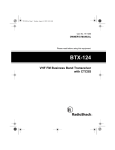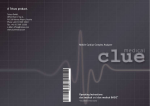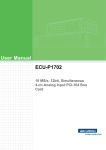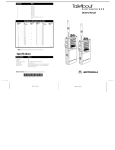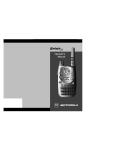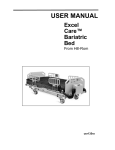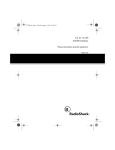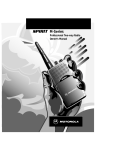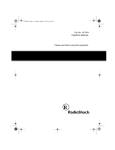Download Radio Shack BTX-128 Owner`s manual
Transcript
19-1217.fm Page 1 Tuesday, August 3, 1999 1:18 PM Cat. No. 19-1217 OWNER’S MANUAL Please read before using this equipment. BTX-128 CTCSS•VHF Business Band Transceiver 19-1217.fm Page 2 Tuesday, August 3, 1999 1:18 PM Features Your RadioShack BTX-128 CTCSS•VHF Business Band Transceiver is a portable, two-way business radio service transceiver that you can carry almost anywhere. The transceiver is compact and light, making it an ideal choice for your business needs. Your transceiver has these features: 38-Tone CTCSS (Continuous Tone Control Squelch System) — helps reduce interference from other transceivers which are operating on the same frequency and in the same area. Built-in VOX — allows hands-free operation of your transceiver using an optional headset and microphone. Rechargeable Battery Pack and Battery Charger — the supplied battery charger lets you conveniently recharge your transceiver’s battery pack while it is on the transceiver. Earphone/Speaker and External Microphone Jacks — let you connect an external earphone or speaker and an external microphone for clearer communications in noisy areas. Battery Low Indication — the transceiver beeps when the battery pack is low. Flexible Antenna — provides excellent reception. Belt Clip — lets you attach the transceiver to your belt or waistband. Programmable Frequencies — you can program the transceiver to any VHF business band frequency you have a license to use — no crystals to buy! © 1998 Tandy Corporation. All Rights Reserved. 2 19-1217.fm Page 3 Tuesday, August 3, 1999 1:18 PM The transceiver’s preset frequencies are: • • • • • • • • • 151.625 MHz (red dot) 151.700 MHz 151.760 MHz 151.820 MHz 151.880 MHz 151.940 MHz 151.955 MHz (purple dot) 154.570 MHz (blue dot) 154.600 MHz (green dot) Note: Some manufacturers identify some business band frequencies by color. These “dot” frequencies are shown above. We recommend you record your transceiver’s serial number here. The number is on the back of the transceiver. WARNING: To reduce the risk of fire or shock hazard, do not expose this product to rain or moisture. CAUTION RISK OF ELECTRIC SHOCK. DO NOT OPEN. ! CAUTION: TO REDUCE THE RISK OF ELECTRIC SHOCK, DO NOT REMOVE COVER OR BACK. NO USER-SERVICEABLE PARTS INSIDE. REFER SERVICING TO QUALIFIED PERSONNEL. This symbol is intended to alert you to the presence of uninsulated dangerous voltage within the product’s enclosure that might be of sufficient magnitude to constitute a risk of electric shock. Do not open the product’s case. Serial Number ____________ ! This symbol is intended to inform you that important operating and maintenance instructions are included in the literature accompanying this product. 3 19-1217.fm Page 4 Tuesday, August 3, 1999 1:18 PM CONTENTS FCC Regulations ................................................................................. 5 FCC License Required .................................................................. 5 FCC Part 90 Rules ........................................................................ 5 Additional FCC Regulations .......................................................... 7 Exposure to Radio Frequency Energy .......................................... 7 Electromagnetic Interference/Compatibility ................................... 8 Potentially Explosive Atmospheres ............................................... 9 Blasting Caps and Areas ............................................................... 9 For Vehicles With an Air Bag ........................................................ 9 Antennas ..................................................................................... 10 Batteries ...................................................................................... 10 Chargers and Power Cord .......................................................... 10 Preparation ........................................................................................ 12 Installing the Battery Pack ........................................................... 12 Charging the Battery Pack .......................................................... 13 Connecting the Antenna .............................................................. 14 Using the Belt Clip ....................................................................... 15 Using an External Speaker/Microphone ...................................... 15 Listening Safely ................................................................... 16 Traffic Safety ....................................................................... 16 Setting Frequency Options ................................................................ About CTCSS ............................................................................. Selecting a Business Band Frequency ...................................... Using a CTCSS Frequency ........................................................ 17 17 18 18 Operation ........................................................................................... 20 Operational Hints ....................................................................... 20 Care and Maintenance ...................................................................... 21 Specifications .................................................................................... 22 4 19-1217.fm Page 5 Tuesday, August 3, 1999 1:18 PM FCC Regulations FCC License Required This transceiver is intended for use in the operation of commercial activities, educational, philanthropic, or ecclesiastical institutions, and hospitals, clinics, or medical associations. The Federal Communications Commission (FCC) requires you to have a license before you operate this transceiver. Unless you are already licensed to operate on one of the preset frequencies, you must apply for a frequency through the PCIA (Personal Communication Industry Association), a non-profit organization that assigns frequencies nationwide to help prevent conflicts between different businesses using transceivers in the same area. For more information about getting a license, contact the PCIA at 800759-0300, extension 3068 (in Virginia 703-739-0300, extension 3068). • To receive all forms and instructions, enter 000600 • To receive Form 600 instructions only, enter 006001 • To receive Main Form 600 only, enter 006002 • To receive Form 600 schedules only, enter 006003 If you do not have a fax machine, you can call the Government Forms Distribution Center at 1800-418-FORM and request that the form and instructions be mailed to you. FCC Part 90 Rules You must be familiar with Part 90 of FCC Rules before you operate your transceiver. The operation instructions in this manual conform to Part 90, but do not cover all items in Part 90. For other questions concerning the license application, contact the FCC at 717-337-1212, or write: FCC P.O. Box 1040 Gettysburg, PA 17325 For the latest FCC application form and instructions, call the FCC’s fax-on-demand service at 1-202-418-0177 from a fax machine and request one or more of the following documents: 5 19-1217.fm Page 6 Tuesday, August 3, 1999 1:18 PM Overall, Part 90 states that: • You must have a valid license before you use the transceiver. • As licensee, you are responsible for proper operation of all transceivers operating under your license authority. • You can let unlicensed persons operate this transmitter, as long as you take precautions to prevent unauthorized transmissions. • You must use this transceiver only for the commercial use of your business, and only when other commercial channels (such as the telephone) are either not available or not practical. • You must always yield the operating frequency to communications that involve the safety of life or property. • You must take reasonable precautions to prevent harmful interference to other services operating on the same frequency. 6 • You must not transmit program material of any kind used in connection with commercial broadcasting. • You must not provide a service that is normally handled by telephone or telegraph unless such broadcasts involve the safety of life or property or in emergencies such as an earthquake, hurricane, flood or a similar disaster where normal communication channels are disrupted. • During each transmission or exchange of transmissions, you must identify your station with the call sign issued to you by the FCC, or once each 15 minutes during periods of continuous operation. • You must keep a written record of any maintenance or modification made to the transceiver, and you must make this record available for inspection upon demand by the FCC. Violating any of the provisions of Part 90 can result in fines and/or confiscation of equipment. 19-1217.fm Page 7 Tuesday, August 3, 1999 1:18 PM Your transceiver might cause TV or radio interference even when it is operating properly. To determine whether your transceiver is causing the interference, turn off your transceiver. If the interference goes away, your transceiver is causing it. Try to eliminate the interference by: • moving your transceiver away from the receiver • contacting your local RadioShack store for help If you cannot eliminate the interference, the FCC requires that you stop using your transceiver. Additional FCC Regulations The Business Radio Service is under the jurisdiction of the (FCC). Any adjustments or alterations that would alter the performance of the transceiver so it no longer meets the original FCC type acceptance or would change the frequency-determining method are strictly prohibited. appropriate license, which you can get by submitting a completed FCC Form 600 to the FCC (or through the PCIA). Furthermore, you are required to understand Part 90 of the FCC Rules and Regulations prior to operating your transceiver. It is the user’s responsibility to see that this unit is operating at all times in accordance with the FCC Rules and Regulations. Exposure to Radio Frequency Energy The design of your radio, which generates radio frequency (RF) electromagnetic energy, complies with the following national and international standards and guidelines: Replacement or substitution of crystals, transistors, ICs, regulator diodes, or any other component that is of a unique nature with components other than those recommended can violate the technical regulations of the FCC rules or violate type acceptance requirements of the rules. Before you operate the transceiver, you must obtain your license. It is illegal to transmit without the 7 19-1217.fm Page 8 Tuesday, August 3, 1999 1:18 PM • FCC Report and Order FCC 96-326 (August 1996) • American National Standards Institute (C95-1-1992) • National Council on Radiation Protection and Measurements (NCRP-1986) • International Commission on Non-Ionizing Radiation Protection (ICNRP-1866) • CENELEC — Env. 50166-1 1995E - Human Exposure to Electromagnetic Fields Low Frequency (0 Hz to 10 KHz) — Env. 50166-2 1995E - Human Exposure to Electromagnetic Fields High Frequency (10 KHz to 300 GHz) — Proceedings of SC211/8 1996 - Safety Considerations for Human Exposure to EMEs from Mobile Telecommunications Equipment (MTE) in the Frequency Range 30 MHz–6 GHz (EME - Electromagnetic Fields) 8 To assure optimal radio performance and to ensure that exposure to RF energy is within the guidelines in these standards, the following operating procedures should be observed: For hand-held operation: The radio should be held in a vertical position with the microphone one to two inches away from the mouth, and the antenna should be kept one to two inches from the head or body when transmitting. For body-worn operation: The antenna should be kept at least one inch from the body when transmitting. ElectromagneticInterference/ Compatibility Nearly every electronic device is susceptible to electromagnetic interference (EMI) if inadequately shielded, de-signed, or otherwise configured for electromagnetic compatibility. Turn your radio off in any facilities where posted notices instruct you to do so. Hospitals or health care facilities 19-1217.fm Page 9 Tuesday, August 3, 1999 1:18 PM may be using equipment that is sensitive to external RF energy. Turn your radio off when on board aircraft when instructed to do so. Any use of the radio must be in accordance with airline regulations or crew instructions. WARNING ! Potentially Explosive Atmospheres Turn your radio off when in any area with a potentially explosive atmosphere, unless it is a type especially qualified for such use (for example, FMRC Approved). Sparks in such areas could cause an explosion or fire resulting in bodily injury or even death. Blasting Caps and Areas To avoid possible interference with blasting operations, turn your radio off near electrical blasting caps or in a ‘blasting area’ or in areas posted “Turn Off Two-Way Radio.” Obey all signs and instructions. For Vehicles With an Air Bag An air bag inflates with great force. Do not place objects, including portable or mobile twoway radios, in the area over the air bag or in the air bag deployment area. If improperly installed or placed wireless equipment is in the air bag deployment area and the air bag inflates, serious injury could result. Do not replace or charge batteries in a hazardous atmosphere. Contact sparking may occur while installing or removing batteries and cause an explosion. Areas with potentially explosive atmospheres are often, but not always, clearly marked. They include fueling areas such as below deck on boats, fuel or chemical transfer or storage facilities, areas where the air contains chemicals or particles such as grain, dust, or metal powders, and any other area where you would normally be advised to turn off your vehicle’s engine. 9 19-1217.fm Page 10 Tuesday, August 3, 1999 1:18 PM Antennas Do not use a radio with a damaged antenna. If a damaged antenna comes into contact with the skin, a minor burn might result. Batteries All batteries can cause property damage, injury, or burns if a conductive material such as jewelry, keys, or a beaded chain touches exposed terminals. The material may complete an electrical circuit (short circuit) and become quite hot. Exercise care in handling any charged battery, particularly when placing it inside a pocket, purse, or other container with metal objects. CAUTION ! Chargers and Power Cord To reduce risk of damage to the supplied battery charger when disconnecting it from AC power, pull by the plug rather than the power cord. Make sure the power cord is located so that it will not be stepped on, tripped over, or otherwise subjected to damage or stress. Do not operate the charger with a damaged cord or plug; replace them immediately. Do not operate the charger if it has received a sharp blow, been dropped, or otherwise damaged in any way; contact your local RadioShack store. 10 Do not expose chargers to rain or snow. An extension cord should not be used unless absolutely necessary. Use of an improper extension cord may result in a fire or electric shock. However, if an extension cord is used, make sure that: • The pins and plug of the extension cord are the same number, size, and shape as those on the plug of the charger. • The extension cord is properly wired and in good condition. • The cord size is 18 AWG for lengths of up to 100 feet, and 15 AWG for lengths up to 150 feet. 19-1217.fm Page 11 Tuesday, August 3, 1999 1:18 PM Do not disassemble your charger. If it does not work; contact your local RadioShack store. Incorrect reassembly can result in electric shock or fire. To reduce risk of injury, use the charger to charge only the type of battery recommended in this Owner’s Manual. Other types of batteries might burst, resulting in personal injury or damage. Use of an attachment not sold or recommended by RadioShack can result in a risk of fire, electric shock, or injury to personnel. To reduce risk of electric shock, unplug the charger from the outlet before cleaning. Turning off controls does not reduce this risk. 11 19-1217.fm Page 12 Tuesday, August 3, 1999 1:18 PM Preparation Installing the Battery Pack The supplied battery pack, when fully charged, provides power to your transceiver for up to 10 hours. You must install the battery pack in your transceiver, then charge it. Caution: Do not remove the plastic wrap from the battery pack. Doing so can permanently damage the battery. 2. Unlock the battery compartment cover by sliding both of the cover’s latches toward the back of the transceiver until you see the orange tabs underneath the latches. Then slide the cover in the direction of the arrow and lift it off. Follow these steps to install the battery pack. 1. Turn the volume control on top of the transceiver fully counterclockwise until it clicks to make sure power is turned off. 12 3. With the battery label facing up, align the contacts on the battery pack with the contacts inside the battery compartment. Then press the battery pack into the compartment while applying slight pressure to the bottom of the battery pack. 19-1217.fm Page 13 Tuesday, August 3, 1999 1:18 PM 4. Slide the battery cover back onto the transceiver, then slide both of the latches toward the front of the transceiver to lock it. To remove the battery pack, unlock the compartment and remove the cover, then turn the transceiver face down and gently tap it into your palm so the battery pack slides out. clicks to make sure power is turned off. 2. Pull out the rubber cover from the charging jack on the side of the transceiver, then 3 insert the charger’s /32inch plug into the jack. Plug the other end of the charger into a standard AC outlet. Charging the Battery Pack Before you use the battery pack for the first time, you must use the supplied battery charger to charge it for about 16 hours to bring it to a full charge. 3. When charging is complete, disconnect the charger from the AC outlet and the transceiver. You cannot use the transceiver while you charge the battery pack. Caution: The supplied battery charger was designed specifically for your transceiver. Use only the supplied battery charger. Follow these steps to charge the battery pack. 1. Turn the volume control on top of the transceiver fully counterclockwise until it 13 19-1217.fm Page 14 Tuesday, August 3, 1999 1:18 PM When the transceiver beeps about 3 to 4 seconds after you turn it on or each time you release PUSH TO TALK, recharge the battery pack. Notes: • A nickel-cadmium battery pack lasts longer and delivers more power if you occasionally let it fully discharge. To do this, use the transceiver until it beeps when you release PUSH TO TALK. • To prevent damaging a nickel-cadmium battery pack, never charge it in an area where the temperature is above 113°F (45°C) or below 32°F (0°C). Important: At the end of a rechargeable battery pack’s useful life, it must be recycled or disposed of properly. Contact your local, county, or state hazardous waste management authorities for information on recycling or disposal programs in your area. Some options that might be available are: municipal curb-side collection, drop-off boxes at retailers such as your local RadioShack 14 store, recycling collection centers, and mail-back programs. Connecting the Antenna Caution: Always connect the supplied antenna to the transceiver before you use it. Thread the supplied flexible antenna clockwise into the top of the transceiver to attach it, or counterclockwise to remove it. 19-1217.fm Page 15 Tuesday, August 3, 1999 1:18 PM Using the Belt Clip Align the belt clip to the mounting rails on the back of the transceiver, then push the clip down until it clicks to lock it. Using an External Speaker/ Microphone An external speaker/microphone (not supplied) can make it easier to use the transceiver when you clip it to your belt, so you do not have to lift the transceiver to your mouth each time you transmit. Plug the speaker/microphone’s plug into the earphone and microphone jacks on the side of the transceiver. This automatically disconnects the transceiver’s built-in speaker and microphone. To remove the belt clip, slide it up while pulling the tab toward the clip. Tab 15 19-1217.fm Page 16 Tuesday, August 3, 1999 1:18 PM Listening Safely Traffic Safety To protect your hearing, follow these guidelines when you use an earphone. Do not use an earphone with your transceiver when operating a motor vehicle or riding a bicycle in or near traffic. Doing so can create a traffic hazard and could be illegal in some areas. • Set the volume to the lowest setting before you begin listening. After you begin listening, adjust the volume to a comfortable level. • Do not listen at extremely high volume levels. Extended high-volume listening can lead to permanent hearing loss. • Once you set the volume, do not increase it. Over time, your ears adapt to the volume level, so a volume level that does not cause discomfort might still damage your hearing. 16 If you use an earphone with your transceiver while riding a bicycle, be very careful. Do not listen to a continuous broadcast. Even though some earphones let you hear some outside sounds when listening at normal volume levels, they still can present a traffic hazard. 19-1217.fm Page 17 Tuesday, August 3, 1999 1:18 PM Setting Frequency Options Before you can use your transceiver, you must set your transceiver to a VHF business band frequency you have a license to use. Then you can select a preset CTCSS (Continuous Tone Control Squelch System) frequency and set your transceiver to use it. Here is what you need to do to set your transceiver to use a business band frequency and CTCSS: þ Select a business band frequency you have a license to use then set your transceiver to that frequency (see “Selecting a Business Band Frequency” on Page 18). À Select a CTCSS frequency then set your transceiver to the code that uses that frequency (see “Using a CTCSS Frequency” on Page 18). Your transceiver’s default CTCSS frequency is 100 Hz. You can select one CTCSS frequency at a time. If you do not want to use a CTCSS frequency, simply do not set your transceiver to use one. About CTCSS CTCSS helps eliminate interference between different users of the same frequency, letting you talk and listen to people who are using other transceivers set to the same frequency and CTCSS code. This is like having a subchannel within a channel, giving you greater communication flexibility. When you set a CTCSS code — there are 38 to choose from — and turn on your transceiver’s CTCSS, the transceiver transmits a tone with your transmission, letting you communicate with anyone who has a transceiver set to the same frequency and code. This tone is too low for you to hear, but other transceivers can detect it. If CTCSS is turned on and set to the same tone on the receiving transceiver, it only receives those transmissions that include the tone. If two different groups operate transceivers in the same area on the same frequency, they do not hear each other’s broadcasts if they both use CTCSS and each select a different CTCSS frequency. 17 19-1217.fm Page 18 Tuesday, August 3, 1999 1:18 PM Selecting a Business Band Frequency 1. While holding PUSH TO TALK, turn on the transceiver. You hear “frequen-cy” and the current frequency setting (“frequency nine,” for example). 2. Choose a business band frequency from the following table. Frequency Freq (MHz) You Hear 151.625 one 151.955 two 154.570 three 154.600 four 151.700 five 151.760 six 151.820 seven 151.880 eight 151.940 nine 3. Repeatedly press PUSH TO TALK to scroll through the transceiver’s business band frequencies. When you hear the business band frequency you have a license to use, release PUSH TO TALK. 4. Press MONITOR twice to store the frequency. 18 Using a CTCSS Frequency Follow these steps to select a CTCSS frequency and activate or deactivate CTCSS. 1. While holding PUSH TO TALK, turn on the transceiver. You hear “frequency” and the current frequency setting (“frequency nine,” for example). 2. Press MONITOR on the side of the transceiver. You hear “code off” or “code” and the transceiver’s current CTCSS code setting (“code seven,” for example). 19-1217.fm Page 19 Tuesday, August 3, 1999 1:18 PM 3. Choose a CTCSS code from the table on Page 19, then repeatedly press PUSH TO TALK to scroll through the transceiver’s CTCSS codes. When you hear the CTCSS code you want, release PUSH TO TALK. CTCSS CTCSS 136.5 two one 141.3 two two 146.2 two three 151.4 two four 156.7 two five 162.2 two six 167.9 two seven 173.8 two eight Freq (Hz) You Hear none off 179.9 two nine 67.0 one 186.2 three zero 71.9 two 192.8 three one 74.4 three 203.5 three two 77.0 four 210.7 three three 79.7 five 218.1 three four 82.5 six 225.7 three five 85.4 seven 233.6 three six 88.5 241.8 three seven eight 250.3 three eight 91.5 nine 94.8 one zero 97.4 one one 100.0 one two 103.5 one three 107.2 one four 110.9 one five 114.8 one six 118.8 one seven 123.0 one eight 127.3 one nine 131.8 two zero 4. Press MONITOR to activate the selected CTCSS code. The transceiver beeps once. 19 19-1217.fm Page 20 Tuesday, August 3, 1999 1:18 PM Operation Note: You can only communicate with another transceiver that is set to the same CTCSS code as your transceiver. 1. Turn the volume control clockwise until it clicks to turn on the transceiver. The transceiver beeps and the transmit light on top of the transceiver flashes. 2. While pressing MONITOR, rotate the volume control to a comfortable listening level. 3. To transmit, hold down PUSH TO TALK. Then hold the transceiver about 3 inches from your mouth and speak slowly in a normal voice. The transmit light on top of the transceiver turns on. Release PUSH TO TALK when you finish your transmission. Note: If you connected an external speaker/microphone to the transceiver, you do not have to lift the transceiver to your mouth or press PUSH TO TALK each time you transmit. To transmit, simply speak into the microphone. 20 4. To turn off the transceiver, turn the volume control counterclockwise until it clicks. Operational Hints Your transceiver’s range varies depending on factors such as position, terrain, and battery condition. Buildings absorb transmitted signals and, if they contain metal, might completely block the signals. Trees and heavy cloud formations have a similar effect, though not as severe. If you are near a lake or the ocean, you might get excellent range. To ensure maximum range, operate the transceiver with the battery pack fully charged. As the voltage decreases, the range decreases. 19-1217.fm Page 21 Tuesday, August 3, 1999 1:18 PM Care AND Maintenance Your RadioShack BTX-128 VHF/FM Business Band Transceiver is an example of superior design and craftsmanship. The following suggestions will help you care for your transceiver so you can enjoy it for years. • Keep the transceiver dry. If it gets wet, wipe it dry immediately. Liquids might contain minerals that can corrode the electronic circuits. • Use and store the transceiver only in normal temperature environments. Temperature extremes can shorten the life of electronic devices, damage batteries, and distort or melt plastic parts. • Keep the transceiver away from dust and dirt, which can cause premature wear of parts. • Handle the transceiver gently and carefully. Dropping it can damage circuit boards and cases and can cause the transceiver to work improperly. • Use only a battery pack of the required size and type. Battery packs can leak chemicals that damage your transceiver’s electronic parts. • Wipe the transceiver with a damp cloth occasionally to keep it looking new. Do not use harsh chemicals, cleaning solvents, or strong detergents to clean the transceiver. Modifying or tampering with the transceiver’s internal components can cause a malfunction and might invalidate your transceiver’s warranty and void your FCC authorization to operate it. If your transceiver is not performing as it should, take it to your local RadioShack store for assistance. 21 19-1217.fm Page 22 Tuesday, August 3, 1999 1:18 PM Specifications Frequency Range ........................................................... 150–160 MHz Channels ................................................................................................. 1 Modulation Type ............................................................................... FM Antenna Impedance ................................................................. 50 Ohm Microphone ....................................................................... Electret Type Power Supply ............................... 7.5V 950 mAh Ni-Cd Battery Pack Note: Do not charge the battery pack at temperatures below 32°F (0°C) or above 113°F (45°C). Sensitivity at 12dB SINAD ........................................................ 0.28 µV Bandwidth ................................................................................ 12.5 KHz Adjacent Channel Rejection .......................................................... 50 dB Audio Output Power ....................... 500mW @ 16 ohm (10% distortion) Audio Distortion ............................................................................... 10% Transmit Power ................................................................................. 1W Harmonic Emission .................................................... Better than 50 dB Dimensions (HWD) .................................... 55/16 × 21/2 × 13/16 Inches (135 × 64 × 30.5 mm) Weight (with battery pack) ............................................................. 11 oz (0.3 kg) Specifications are typical; individual units might vary. Specifications are subject to change and improvement without notice. 22 19-1217.fm Page 23 Tuesday, August 3, 1999 1:18 PM NOTES 23 19-1217.fm Page 24 Tuesday, August 3, 1999 1:18 PM Limited One-Year Warranty This product is warranted by RadioShack against manufacturing defects in material and workmanship under normal use for one (1) year from the date of purchase from RadioShack company-owned stores and authorized RadioShack franchisees and dealers. EXCEPT AS PROVIDED HEREIN, RadioShack MAKES NO EXPRESS WARRANTIES AND ANY IMPLIED WARRANTIES, INCLUDING THOSE OF MERCHANTABILITY AND FITNESS FOR A PARTICULAR PURPOSE, ARE LIMITED IN DURATION TO THE DURATION OF THE WRITTEN LIMITED WARRANTIES CONTAINED HEREIN. EXCEPT AS PROVIDED HEREIN, RadioShack SHALL HAVE NO LIABILITY OR RESPONSIBILITY TO CUSTOMER OR ANY OTHER PERSON OR ENTITY WITH RESPECT TO ANY LIABILITY, LOSS OR DAMAGE CAUSED DIRECTLY OR INDIRECTLY BY USE OR PERFORMANCE OF THE PRODUCT OR ARISING OUT OF ANY BREACH OF THIS WARRANTY, INCLUDING, BUT NOT LIMITED TO, ANY DAMAGES RESULTING FROM INCONVENIENCE, LOSS OF TIME, DATA, PROPERTY, REVENUE, OR PROFIT OR ANY INDIRECT, SPECIAL, INCIDENTAL, OR CONSEQUENTIAL DAMAGES, EVEN IF RadioShack HAS BEEN ADVISED OF THE POSSIBILITY OF SUCH DAMAGES. Some states do not allow the limitations on how long an implied warranty lasts or the exclusion of incidental or consequential damages, so the above limitations or exclusions may not apply to you. In the event of a product defect during the warranty period, take the product and the RadioShack sales receipt as proof of purchase date to any RadioShack store. RadioShack will, at its option, unless otherwise provided by law: (a) correct the defect by product repair without charge for parts and labor; (b) replace the product with one of the same or similar design; or (c) refund the purchase price. All replaced parts and products, and products on which a refund is made, become the property of RadioShack. New or reconditioned parts and RadioShack A Division of Tandy Corporation Fort Worth, Texas 76102 09/98 Printed in the USA
























